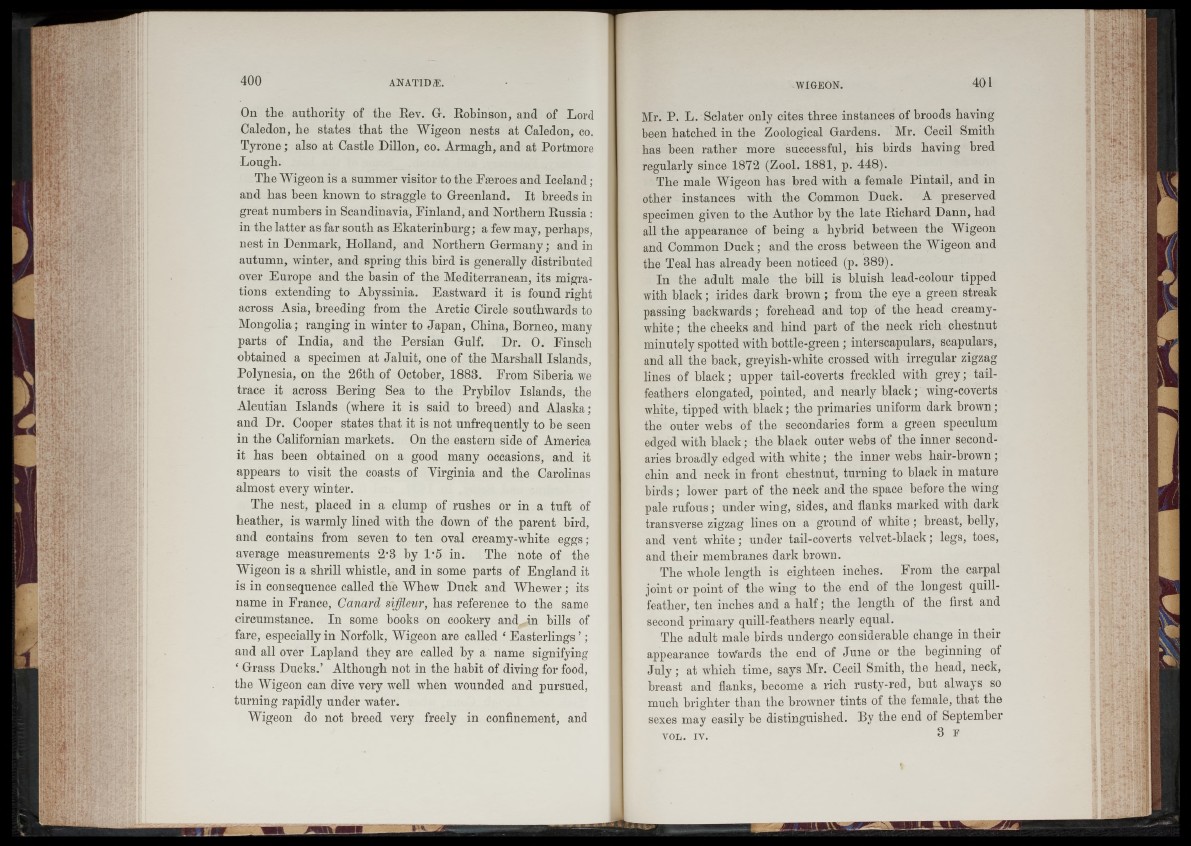
On the authority of the Rev. G. Robinson, and of Lord
Caledon, he states that the Wigeon nests at Caledon, co.
Tyrone; also at Castle Dillon, co. Armagh, and at Portmore
Lough.
The Wigeon is a summer visitor to the Faeroes and Iceland;
and has been known to straggle to Greenland. It breeds in
great numbers in Scandinavia, Finland, and Northern Russia :
in the latter as far south as Ekaterinburg; a few may, perhaps,
nest in Denmark, Holland, and Northern Germany; and in
autumn, winter, and spring this bird is generally distributed
over Europe and the basin of the Mediterranean, its migrations
extending to Abyssinia. Eastward it is found right
across Asia, breeding from the Arctic Circle southwards to
Mongolia; ranging in winter to Japan, China, Borneo, many
parts of India, and the Persian Gulf. Dr. 0. Finsch
obtained a specimen at Jaluit, one of the Marshall Islands,
Polynesia, on the 26tli of October, 1883. From Siberia we
trace it across Bering Sea to the Prybilov Islands, the
Aleutian Islands (where it is said to breed) and Alaska;
and Dr. Cooper states that it is not unfrequently to be seen
in the Californian markets. On the eastern side of America
it has been obtained on a good many occasions, and it
appears to visit the coasts of Virginia and the Carolinas
almost every winter.
The nest, placed in a clump of rushes or in a tuft of
heather, is warmly lined with the down of the parent bird,
and contains from seven to ten oval creamy-white eggs;
average measurements 2*3 by 1-5 in. The note of the
Wigeon is a shrill whistle, and in some parts of England it
is in consequence called the Whew Duck and Whewer; its
name in France, Canard siffleur, has reference to the same
circumstance. In some books on cookery and in bills of
fare, especially in Norfolk, Wigeon are called ‘ Easterlings ’ ;
and all over Lapland they are called by a name signifying
‘ Grass Ducks.’ Although not in the habit of diving for food,
the Wigeon can dive very well when wounded and pursued,
turning rapidly under water.
Wigeon do not breed very freely in confinement, and
Mr. P. L. Sclater only cites three instances of broods having
been hatched in the Zoological Gardens. Mr. Cecil Smith
has been rather more successful, his birds having bred
regularly since 1872 (Zool. 1881, p. 448).
The male Wigeon has bred with a female Pintail, and in
other instances with the Common Duck. A preserved
specimen given to the Author by the late Richard Dann, had
all the appearance of being a hybrid between the Wigeon
and Common Duck; and the cross between the Wigeon and
the Teal has already been noticed (p. 389).
In the adult male the bill is bluish lead-colour tipped
with black; hides dark brown ; from the eye a green streak
passing backwards ; forehead and top of the head creamy-
white ; the cheeks and hind part of the neck rich chestnut
minutely spotted with bottle-green ; interscapulars, scapulars,
and all the back, greyish-white crossed with irregular zigzag
lines of black; upper tail-coverts freckled with grey; tail-
feathers elongated, pointed, and nearly black; wing-coverts
white, tipped with black; the primaries uniform dark brown;
the outer webs of the secondaries form a green speculum
edged with black; the black outer webs of the inner secondaries
broadly edged with white ; the inner webs hair-brown ;
chin and neck in front chestnut, turning to black in mature
birds; lower part of the neck and the space before the wing
pale rufous; under wing, sides, and flanks marked with dark
transverse zigzag lines on a ground of white ; breast, belly,
and vent white; under tail-coverts velvet-black; legs, toes,
and their membranes dark brown.
The whole length is eighteen inches. From the carpal
joint or point of the wing to the end of the longest quill-
featlier, ten inches and a half; the length of the first and
second primary quill-featliers nearly equal.
The adult male birds undergo considerable change in their
appearance towards the end of June or the beginning of
July ; at which time, says Mr. Cecil Smith, the head, neck,
breast and flanks, become a rich rusty-red, but always so
much brighter than the browner tints of the female, that the
sexes may easily be distinguished. By the end of September
VOL. iv. ^ F